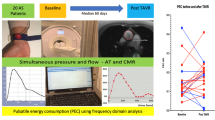Abstract
Backgound
Abdominal aortic aneurysm (AAA) surgery provides a unique opportunity to study the impact of arterial stiffness on central haemodynamics, reflected in augmentation index (AI). The aneurysmal aorta is significantly stiffer than undilated age-matched aorta.
Aim
We investigated whether replacement of an aneurysmal aorta with a compliant graft would result in a decrease in AI, which would thus decrease myocardial workload parameters.
Methods
Patients undergoing elective open or endovascular AAA repair were assessed with applanation tonometry and laser fluximetry pre-operatively, immediately and long-term post-operatively.
Results
Replacement of a small segment of abnormal conduit vessel resulted in improvements in AI, demonstrating that arterial stiffness can be surgically manipulated.
Conclusions
These results reflect a decreased myocardial workload post-aortic grafting. This decrease in AI is important from a risk factor management perspective, and arterial stiffness should become a further recognised and screened for risk factor in patients with known aneurysmal disease.
Similar content being viewed by others
References
Cervantes J (2003) Reflections on the 50th anniversary of the first abdominal aortic aneurysm resection. World J Surg 27(2):246–248
Sumner DS, Hokanson DE, Strandness DE Jr (1970) Stress-strain characteristics and collagen-elastin content of abdominal aortic aneurysms. Surg Gynecol Obstet 130(3):459–466
Anidjar S, Salzmann JL, Gentric D et al (1990) Elastase-induced experimental aneurysms in rats. Circulation 82(3):973–981
Dobrin PB, Baker WH, Gley WC (1984) Elastolytic and collagenolytic studies of arteries. Implications for the mechanical properties of aneurysms. Arch Surg 119(4):405–409
MacSweeney ST, Young G, Greenhalgh RM, Powell JT (1992) Mechanical properties of the aneurysmal aorta. Br J Surg 79(12):1281–1284
Sonesson B, Hansen F, Lanne T (1997) Abdominal aortic aneurysm: a general defect in the vasculature with focal manifestations in the abdominal aorta. J Vasc Surg 26(2):247–254
Midttun M, Sejrsen P, Paaske WP (1999) Peripheral blood flow rates and microvascular responses to orthostatic pressure changes in claudicants before and after revascularisation. Eur J Vasc Endovasc Surg 17(3):225–229
Midttun M, Sejrsen P, Paaske WP (2000) Is non-specific aneurysmal disease of the infrarenal aorta also a peripheral microvascular disease. Eur J Vasc Endovasc Surg 19(6):625–629
Ferro CR, de Oliveira DC, Guerra Fde F et al (2007) Prevalence and risk factors for combined coronary artery disease and aortic aneurysm. Arq Bras Cardiol 88(1):40–44
Alcorn HG, Wolfson SK Jr, Sutton-Tyrrell K et al (1996) Risk factors for abdominal aortic aneurysms in older adults enrolled in the Cardiovascular Health Study. Arterioscler Thromb Vasc Biol 16(8):963–970
Bengtsson H, Sonesson B, Bergqvist D (1996) Incidence and prevalence of abdominal aortic aneurysms, estimated by necropsy studies and population screening by ultrasound. Ann N Y Acad Sci 800:1–24
Shi Q, Wu MH, Hayashida N et al (1994) Proof of fallout endothelialization of impervious Dacron grafts in the aorta and inferior vena cava of the dog. J Vasc Surg 20(4):546–556 (discussion 556–557)
Hayashi T, Nakayama Y, Tsumura K et al (2002) Reflection in the arterial system and the risk of coronary heart disease. Am J Hypertens 15(5):405–409
Imanishi R, Seto S, Toda G et al (2004) High brachial-ankle pulse wave velocity is an independent predictor of the presence of coronary artery disease in men. Hypertens Res 27(2):71–78
Weber T, Auer J, O’Rourke MF et al (2004) Arterial stiffness, wave reflections, and the risk of coronary artery disease. Circulation 109(2):184–189
London GM, Blacher J, Pannier B et al (2001) Arterial wave reflections and survival in end-stage renal failure. Hypertension 38(3):434–438
Chirinos JA, Zambrano JP, Chakko S et al (2005) Aortic pressure augmentation predicts adverse cardiovascular events in patients with established coronary artery disease. Hypertension 45(5):980–985
Author information
Authors and Affiliations
Corresponding author
Rights and permissions
About this article
Cite this article
Moloney, M.A., McHugh, S., O’ Donnell, D.H. et al. Comparison of arterial stiffness and microcirculatory changes following abdominal aortic aneurysm grafting. Ir J Med Sci 180, 375–378 (2011). https://doi.org/10.1007/s11845-010-0513-3
Received:
Accepted:
Published:
Issue Date:
DOI: https://doi.org/10.1007/s11845-010-0513-3




